
In the late nineteenth century the land around the Bering Sea supported more than seven thousand Eskimo people living in permanent villages. These people developed an ingenious hunting technology and an elaborate religious and ceremonial life. The village described in this essay was located near the mouth of the Yukon River and numbered about 125 inhabitants.
The houses of this village were very different from the houses of ice built by Eskimo peoples farther north. Here each house was rectangular in shape and sturdily built from driftwood logs covered with sod.
Villagers built every house to be cozy and warm. A long passageway led from the outside door to the living area several feet below ground level. Sleeping ledges covered with soft furs adorned the walls. Light and heat came from a central fireplace and from saucer-shaped clay lamps placed on the sleeping ledges.
Several families related through marriage shared each house. Married couples had their own sleeping ledge, and each woman had her own lamp. Sometimes only the women and children slept in the houses, especially during winter festivals when the men and older boys slept in the qasgiq (khuzz'-a-gick), or men's council house.
During the summer months, groups of two or three families each moved to inland camps. Throughout the mild summer days, women and younger children searched for berries, roots, grasses, and leaves while men and older boys hunted and fished.